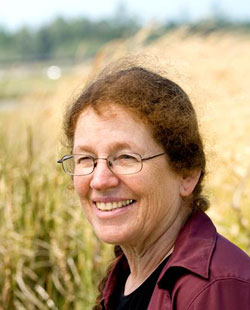
Now in paperback, the chronicle of “who survives disaster and why” has been hailed by critics nationwide as "a book that could save your life." It examines lessons learned from human behavior in sudden catastrophes and how to improve people’s reactions. Practice drills are indispensable and North Coast authorities will conduct a tsunami alert test Mar. 23.
Time magazine's Amanda Ripley, The Unthinkable’s author, explains that "our disaster personalities can be quite different from the ones we expect to meet," for better and for worse. Hence the need for preparation and readiness.
Dengler accentuates the positive in sharing her findings with Ripley from the Southeast Asian earthquake/tsunami of December, 2004. The survivors of Langi village were alerted a tsunami might be on its way when the ground shook. They promptly climbed to a nearby hill and stayed put, because, in Ripley's words, "That was the tradition, no matter what. In 1907, the island [of Simeulue] had experienced a tsunami, which locals say killed about 70% of the population. And the survivors had passed this lesson on through the generations in Langi and other towns. Everyone knew the word 'smong,' the word for tsunami in the Simeulue language."
Dengler said the villagers pointed to the hill, about 100 feet high, when she asked where they went when the ground vibrated—"right about where I would have told them to go."
Only seven of 78,000 Simeuleu island residents perished in the 2004 tsunami. To a person, the dead were trying to save their belongings, a common tendency in disasters that The Unthinkable casts behavioral light on.
On the other hand, Dengler found the residents of Langi proud of their devotion to evacuating, never considering a false evacuation a waste of time. Their belongings were the last things on their minds when the ground rumbled.
Both Dengler and Ripley emphasize that survival is not a matter of chance, and that people must help one another because government and emergency responders cannot provide immediate protection.
Two other North Coast stories appear in Ripley’s account. The chapter titled “Heroes” stems largely from the pioneering altruism research of Humboldt State emeriti professors Sam and Pearl Oliner. Neither religious orientation nor political belief necessarily predicts heroic behavior, they found, and a hero’s most important character attribute is likely to be empathy.
The Oliners also concluded that rescuers were likely to have been disciplined with reason when they were children; non-rescuers were more likely to have been whipped.
The Unthinkable also describes California’s first-ever tsunami evacuation drill in the town of Samoa in mid-2007 as illustrative of what communities can do to increase their chances of survival. Troy Nicolini, a meteorologist with the local National Weather Service office, gathered advice from locals on where to plant evacuation route signs. In the drill, all evacuated successfully, including a wheelchair-bound woman who got a hands-on assist from neighbors.
“Everybody made it to the top in 10 minutes, which is about all the warning they might have in real life,” Ripley commented.
North Coast residents will have another opportunity to improve their preparedness on Mar. 23, when Del Norte, Humboldt, and Mendocino Counties will conduct a tsunami warning communication test. It will start at 11:45 Wednesday morning and last 15 minutes. The test will be administered by the National Weather Service, the California Emergency Management Agency, Tribal Governments and the Del Norte, Humboldt and Mendocino Offices of Emergency Services.
Local media, television and radio, will broadcast crawlers and announcements. (Some cable television stations may not be able to participate). Humboldt State will take part in the annual spring test of the Emergency Alert System to ensure it would function properly in the event of an actual emergency. The Mar. 23 exercise is the sequel to the annual California Shakeout earthquake drill each October.
The upcoming drill reminds residents of the locations of the Humboldt Bay region's tsunami evacuation areas; maps are posted at http://www.humboldt.edu/shakyground/.
Blue and white "Entering Tsunami Hazard Zone" signs are situated at various coastal locations at ground level.
Survival tips include creation of family preparedness and evacuation plans and purchase of household disaster supply kits. These include ample food and water, blankets, flashlights, copies of vital documents and important family-shared telephone numbers.
Some schools and communities in the three test counties may practice their own evacuation drills on Mar. 23, but the simulation will not require evacuations from homes or businesses, or telephone calls to local authorities. Some locales will hear the sounding of a tsunami siren or an aircraft testing its public address system. No response or action will be required.
Comprehensive information about preparedness on the North Coast, where a magnitude 6.5 earthquake occurred in January, 2010, is posted at http://humboldt.edu/shakyground. It includes the latest edition of the definitive guidebook, “Living on Shaky Ground.”
“We live in prime earthquake and tsunami country up here,” Dengler cautions.